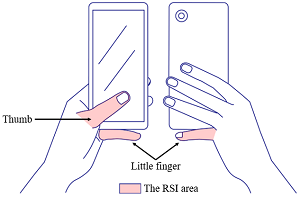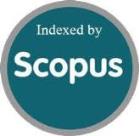A Novel Diagnostic Approach for Smartphone-Induced Finger Disorders: An Exploratory Study
DOI:
https://doi.org/10.46604/peti.2024.14428Keywords:
repetitive strain injury, smartphone-related finger injuries, soft tissue stiffness, vibration frequency featuresAbstract
Smartphone-related finger injuries are repetitive strain injuries caused by prolonged smartphone use. Despite the increasing prevalence of such conditions, few studies have focused on developing effective and accessible diagnostic methods. This study proposes the use of biomedical signals from the hand and fingers as diagnostic indices. Soft tissue stiffness and vibration frequency features under load are presented and tested as potential diagnostic indices. Testing revealed that the soft tissue stiffness parameter lacks reliability and suitable sensors, while the vibration frequency feature demonstrates excellent performance. After addressing several existing limitations, the vibration frequency under load emerges as the optimal diagnostic method for smartphone-related finger injuries.
References
S. A. Karim, “From ‘Playstation Thumb’ to ‘Cellphone Thumb’: The New Epidemic in Teenagers,” SAMJ: South African Medical Journal, vol. 99, no. 3, pp. 161-162, 2009.
A. Yassi, “Repetitive Strain Injuries,” The Lancet, vol. 349, no. 9056, pp. 943-947, 1997.
K. Okeleke, “The Mobile Economy 2021,” https://www.gsmaintelligence.com/research/the-mobile-economy-2021, 2021.
B. Cohen, “How Much Does a Smartphone Weigh?” https://devicetests.com/how-much-does-a-smartphone-weigh, 2022.
J. De-Sola Gutiérrez, F. Rodríguez de Fonseca, and G. Rubio, “Cell-Phone Addiction: A Review,” Frontiers in Psychiatry, vol. 7, article no. 175, 2016.
M. Ali, M. Asim, S. H. Danish, F. Ahmad, A. Iqbal, and S. D. Hasan, “Frequency of De Quervain’s Tenosynovitis and Its Association with SMS Texting,” Muscles, Ligaments and Tendons Journal, vol. 4, no. 1, pp. 74-78, 2014.
S. Bismillah, A. Iqra, R. Sidra, and R. Anum, “Frequency of Thumb Pain Among Mobile Phone User Students,” Journal of Sheikh Zayed Medical College, vol. 9, no. 2, pp. 1406-1408, 2018.
M. Gertsch, The ECG: A Two-Step Approach to Diagnosis. Berlin: Springer, 2004.
R. Gong, H. Ohtsu, K. Hase, and S. Ota, “Vibroarthrographic Signals for the Low-Cost and Computationally Efficient Classification of Aging and Healthy Knees,” Biomedical Signal Processing and Control, vol. 70, article no. 103003, 2021.
R. Gong and K. Hase, “Swarm Intelligence Algorithm Based on Plant Root System in 1D Biomedical Signal Feature Engineering to Improve Classification Accuracy,” Advances in Technology Innovation, vol. 8, no. 3, pp. 163-176, 2023.
D. Hochman, “Measuring and Analyzing Joint Acoustic Emissions from the Wrist,” Ph.D. dissertation, Georgia Institute of Technology, 2021.
D. G. Eitzen and H. N. G. Wadley, “Acoustic Emission: Establishing the Fundamentals,” Journal of Research of the National Bureau of Standards, vol. 89, no. 1, pp. 75-100, 1984.
R. K. A. Prasad, S. S. Babu, N. Siddaiah, and K. S. Rao, “A Review on Techniques for Diagnosing and Monitoring Patients with Parkinson’s Disease,” Journal of Biosensors & Bioelectronics, vol. 7, no. 2, article no. 1000203, 2016.
H. M. Schmidt and U. Lanz, Surgical Anatomy of the Hand, Stuttgart: Thieme, 2004.
W. P. 3rd Cooney and E. Y. Chao, “Biomechanical Analysis of Static Forces in the Thumb During Hand Function,” The Journal of Bone & Joint Surgery, vol. 59, no. 1, pp. 27-36, 1977.
J. W. Griffin, “Hemiplegic Shoulder Pain,” Physical Therapy, vol. 66, no. 12, pp. 1884-1893, 1986.
A. Takanashi, H. Karasuno, K. Shiota, T. Fujiwara, R. Konuma, K. Abe, et al., “Reproducibility and Reliability of Two Kinds of Soft Tissue Stiffness Meter,” Rigakuryoho Kagaku, vol. 23, no. 2, pp. 297-300, 2008.
RStudio Team, RStudio: Integrated Development Environment for R, 2021.
JASP Team, JASP (Version 0.17), 2023.
R. Gong, K. Hase, H. Goto, K. Yoshioka, and S. Ota, “Knee Osteoarthritis Detection Based on the Combination of Empirical Mode Decomposition and Wavelet Analysis,” Journal of Biomechanical Science and Engineering, vol. 15, no. 3, article no. 00017, 2020.
M. R. Ahsan, M. I. Ibrahimy, and O. O. Khalifa, “Electromygraphy (EMG) Signal Based Hand Gesture Recognition Using Artificial Neural Network (ANN),” 4th International Conference on Mechatronics, pp. 1-6, 2011.
V. Krishnamoorthy, M. L. Latash, J. P. Scholz, and V. M. Zatsiorsky, “Muscle Synergies During Shifts of the Center of Pressure by Standing Persons,” Experimental Brain Research, vol. 152, pp. 281-292, 2003.
Q. Li, R. Gong, and K. Hase, “A Comprehensive Objective Evaluation Method for Handwriting Assistive Devices Using a Tablet and Digital Pen for Individuals with Upper Limb Dysfunction,” Applied Sciences, vol. 14, no. 23, article no. 11190, 2024.

Published
How to Cite
Issue
Section
License
Copyright (c) 2025 Rui Gong, Kazunori Hase, Qian Li, Sentong Wang

This work is licensed under a Creative Commons Attribution-NonCommercial 4.0 International License.
Submission of a manuscript implies: that the work described has not been published before that it is not under consideration for publication elsewhere; that if and when the manuscript is accepted for publication. Authors can retain copyright of their article with no restrictions. Also, author can post the final, peer-reviewed manuscript version (postprint) to any repository or website.

Since Oct. 01, 2015, PETI will publish new articles with Creative Commons Attribution Non-Commercial License, under The Creative Commons Attribution Non-Commercial 4.0 International (CC BY-NC 4.0) License.
The Creative Commons Attribution Non-Commercial (CC-BY-NC) License permits use, distribution and reproduction in any medium, provided the original work is properly cited and is not used for commercial purposes







